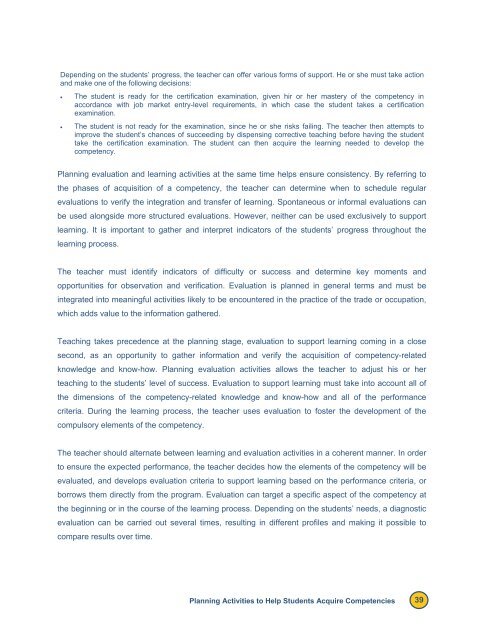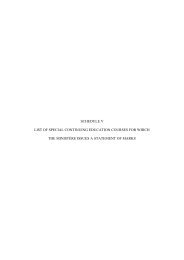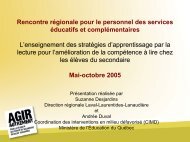Reference Framework for Planning Learning and Evaluation Activities
Reference Framework for Planning Learning and Evaluation Activities
Reference Framework for Planning Learning and Evaluation Activities
Create successful ePaper yourself
Turn your PDF publications into a flip-book with our unique Google optimized e-Paper software.
Depending on the students’ progress, the teacher can offer various <strong>for</strong>ms of support. He or she must take action<br />
<strong>and</strong> make one of the following decisions:<br />
• The student is ready <strong>for</strong> the certification examination, given hir or her mastery of the competency in<br />
accordance with job market entry-level requirements, in which case the student takes a certification<br />
examination.<br />
• The student is not ready <strong>for</strong> the examination, since he or she risks failing. The teacher then attempts to<br />
improve the student’s chances of succeeding by dispensing corrective teaching be<strong>for</strong>e having the student<br />
take the certification examination. The student can then acquire the learning needed to develop the<br />
competency.<br />
<strong>Planning</strong> evaluation <strong>and</strong> learning activities at the same time helps ensure consistency. By referring to<br />
the phases of acquisition of a competency, the teacher can determine when to schedule regular<br />
evaluations to verify the integration <strong>and</strong> transfer of learning. Spontaneous or in<strong>for</strong>mal evaluations can<br />
be used alongside more structured evaluations. However, neither can be used exclusively to support<br />
learning. It is important to gather <strong>and</strong> interpret indicators of the students’ progress throughout the<br />
learning process.<br />
The teacher must identify indicators of difficulty or success <strong>and</strong> determine key moments <strong>and</strong><br />
opportunities <strong>for</strong> observation <strong>and</strong> verification. <strong>Evaluation</strong> is planned in general terms <strong>and</strong> must be<br />
integrated into meaningful activities likely to be encountered in the practice of the trade or occupation,<br />
which adds value to the in<strong>for</strong>mation gathered.<br />
Teaching takes precedence at the planning stage, evaluation to support learning coming in a close<br />
second, as an opportunity to gather in<strong>for</strong>mation <strong>and</strong> verify the acquisition of competency-related<br />
knowledge <strong>and</strong> know-how. <strong>Planning</strong> evaluation activities allows the teacher to adjust his or her<br />
teaching to the students’ level of success. <strong>Evaluation</strong> to support learning must take into account all of<br />
the dimensions of the competency-related knowledge <strong>and</strong> know-how <strong>and</strong> all of the per<strong>for</strong>mance<br />
criteria. During the learning process, the teacher uses evaluation to foster the development of the<br />
compulsory elements of the competency.<br />
The teacher should alternate between learning <strong>and</strong> evaluation activities in a coherent manner. In order<br />
to ensure the expected per<strong>for</strong>mance, the teacher decides how the elements of the competency will be<br />
evaluated, <strong>and</strong> develops evaluation criteria to support learning based on the per<strong>for</strong>mance criteria, or<br />
borrows them directly from the program. <strong>Evaluation</strong> can target a specific aspect of the competency at<br />
the beginning or in the course of the learning process. Depending on the students’ needs, a diagnostic<br />
evaluation can be carried out several times, resulting in different profiles <strong>and</strong> making it possible to<br />
compare results over time.<br />
<strong>Planning</strong> <strong>Activities</strong> to Help Students Acquire Competencies 39




